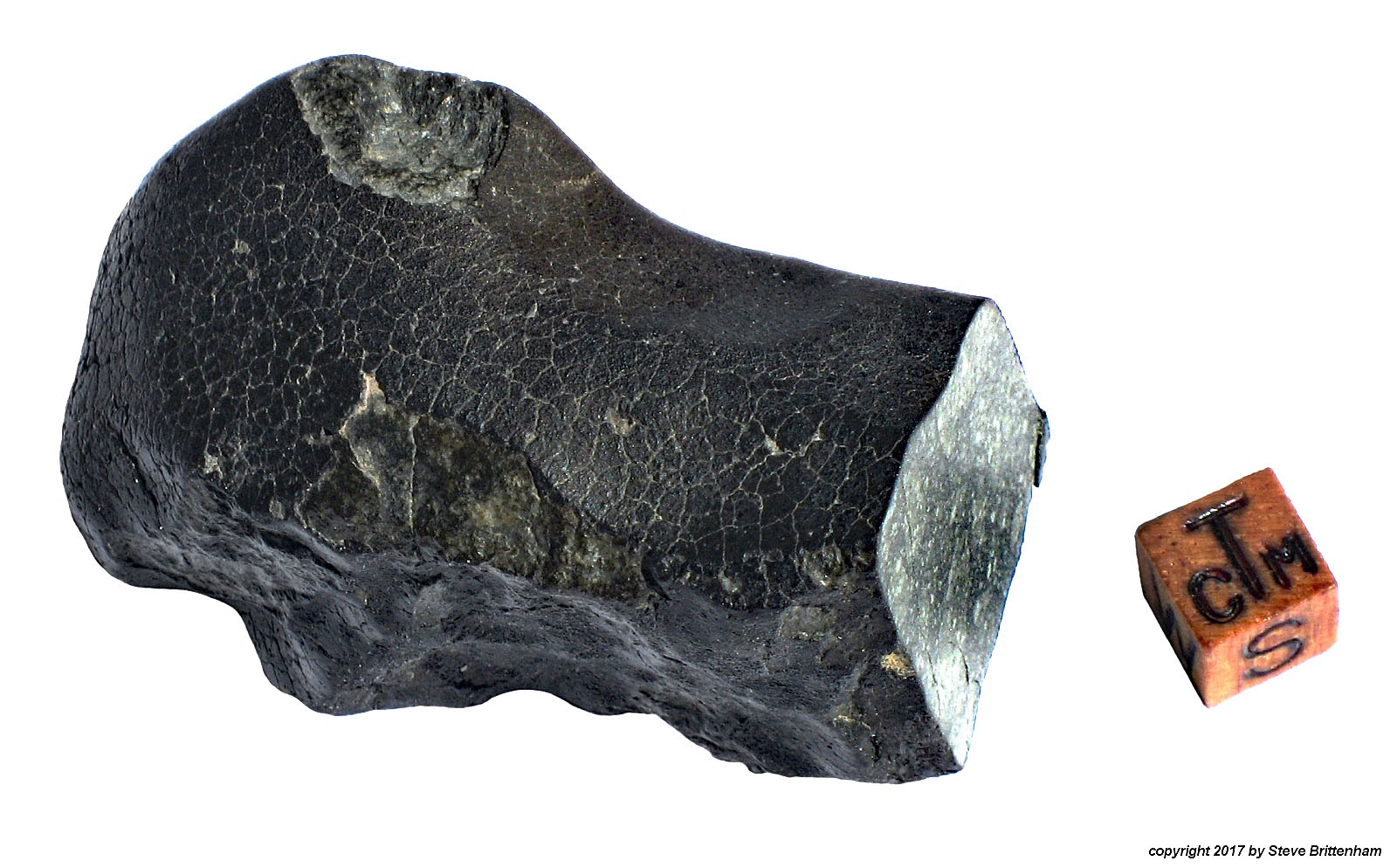|
Roll Overs:
#1
#2
#3
#4
#5
#6
|

|
|
Copyright (c) Steve Brittenham.
|
151.9 grams. 61 x 34 x 33 mm. R4
TKW 170 grams. Fall not observed. Found 2005.
  
Steve writes:
Rumurutiites are mostly breccias containing a variety of different rock fragments embedded in a clastic matrix. They contain fewer chondrules than ordinary or enstatite chondrites and are thought to have a regolith origin, as most have high amounts of noble gases likely implanted by the solar wind at the surface of their as yet unidentified parent body. Originally called the Carlisle Lakes group after a meteorite found in Australia in 1977, they’re now named after the Rumuruti meteorite that fell in Kenya, Africa, in 1934 (initially Rumuruti was thought to be an anomalous chondrite, but in 1993 it was reclassified as the type specimen for the then newly created R-chondrite group).
The 151.9 gram individual seen in Photos 1 through 4 measures 61 x 34 x 33 mm and is the main mass of an R4 rumurutiite (a separate approximately 19 gram end piece was cut off for classification and currently resides at ASU – it’s shown in Photo 5’s composite made from images provided to me by Dr. Ted Bunch, who classified it). NWA 4288’s type 4 designation describes abundant chondrules that have been metamorphosed under conditions sufficient to homogenize olivine compositions and to recrystallize the fine-grained matrix. The iron-rich olivines along with the oxidized nature of any free iron in R-chondrites give most a reddish-brown appearance; but this one is atypically gray that, along with the well-defined and largely intact fusion crust, suggests it’s one of the fresher R-chondrites.
Broken areas show a couple of different characteristics, as illustrated in Photo 4. The upper left image demonstrates a gray colored interior consistent with the cut surfaces seen in Photos 2 and 5. But the lower left and upper right images in Photo 4 show reddish-brown materials within the broken “windows”. Close inspection with a loupe suggests they are layers of melted silicate that separates the fusion crust from the interior (although hard to see, at the left of the “window” in the upper right image of Photo 4 is a thin oval-shaped layer of this reddish-brown material sitting on top of the grayish interior exposed to its right). Finally, while most of the metal within R-chondrites is either oxidized or found in the form of iron sulfides, this particular piece is very slightly attracted to a large rare earth magnet, and inspection of the cut edge with a high powered loupe shows near-microscopic flecks of iron-nickel scattered throughout its surface. Presumably the reddish area seen in the lower right image of Photo 4 is a consequence of a higher concentration of metal in this area that subsequently oxidized (additionally, Photo 3 shows that this surface is much different in texture and color than the other three long surfaces of this roughly rectangular meteorite).
This and the classification sample are the only two pieces of this meteorite (as Dr. Bunch pointed out, a comparison of the breccia’s characteristics in the cut faces in Photos 2 and 5 show a generally mirror image, indicating that no additional slices were removed from either piece). Some have confused NWA 4288 with the NWA 6491 R-chondrite, but as seen in Photo 6’s 9.0 gram, 51 x 49 x 1 mm slice of that meteorite, they are obviously far different in both size and color.
Click to view larger photos #1 #2 #3 #4 #5 #6
|
| |
Steve Brittenham
6/5/2017 10:24:01 AM |
Thanks, Bernd - they are pretty intense in spots. And Graham, that would be cool if you did! But I do understand not wanting to cut nice looking stones on the chance they may not turn out to be rare after all. Aras Jonikas (AJ Meteorites) recently listed a non-brecciated R4 that reminded me a little of this one, but I haven*t looked at the chemistry or other details to know if it might possibly be related. Conversely, it*s unfortunate that NWA 6491 slices and thin sections are being sold as NWA 4288. NWA 6491 is a great R3-5, but I don*t know how the two can be confused! |
Bernd Pauli
6/5/2017 4:47:59 AM |
Beautiful contraction cracks! |
Graham
6/5/2017 3:26:03 AM |
I think I mat have a paired stone to this...just so beautiful the dilemma is where to cut for analysis.
|
| |
|